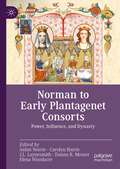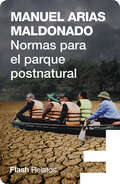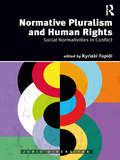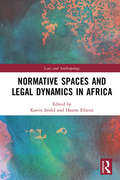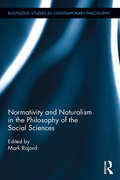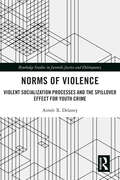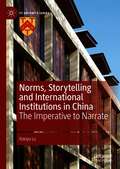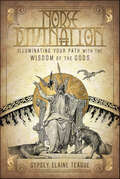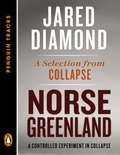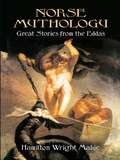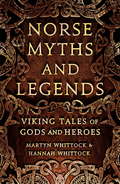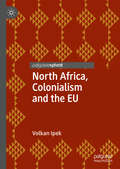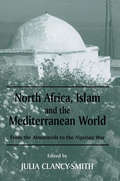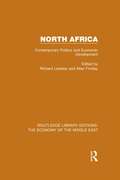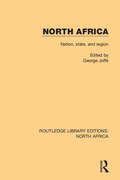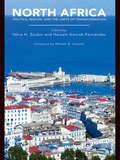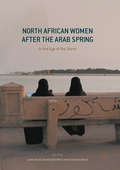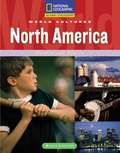- Table View
- List View
Norman to Early Plantagenet Consorts: Power, Influence, and Dynasty (Queenship and Power)
by Elena Woodacre Carolyn Harris J. L. Laynesmith Aidan Norrie Danna R. MesserThis book examines the emergence of the queen consort in medieval England, beginning with the pre-Conquest era and ending with death of Margaret of France, second wife of Edward I, in 1307. Though many of the figures in this volumes are well known, such as Eleanor of Aquitaine and Eleanor of Castille, the chapters here are unique in the equal consideration given to the tenures of the lesser known consorts, including: Adeliza of Louvain, second wife of Henry I; Margaret of France, wife of Henry the Young King; and even Isabella of Gloucester, the first wife of King John. These innovative and thematic biographies highlight the evolution of the office of the queen and the visible roles that consorts played, which were integral to the creation of the identity of early English monarchy. This volume and its companions reveal the changing nature of English consortship from the Norman Conquest to today.
Normas para el parque posnatural
by Manuel Arias MaldonadoUna reflexión sobre la relación entre la sociedad y la naturaleza en el contexto del cambio climático. En este ensayo, Manuel Arias Maldonado reflexiona sobre implicaciones filosóficas y morales relacionadas con el cambio climático. ¿Podemos conseguir frenarlo sin alterar los límites de las libertades individuales? ¿Es posible volver al período anterior al Antropoceno? ¿Hasta qué punto son compatibles los principios para preservar la naturaleza con las sociedades liberales? A través de estas preguntas, el autor plantea la necesidad de problematizar conceptos como democracia o esfera privada, con tal de garantizar la supervivencia de la especie. Ya que, tal como él mismo afirma, «cuidar del entorno natural es cuidar de la libertad de los ciudadanos del futuro.»
Normative Pluralism and Human Rights: Social Normativities in Conflict (Juris Diversitas)
by Kyriaki TopidiThe complex legal situations arising from the coexistence of international law, state law, and social and religious norms in different parts of the world often include scenarios of conflict between them. These conflicting norms issued from different categories of ‘laws’ result in difficulties in describing, identifying and analysing human rights in plural environments. This volume studies how normative conflicts unfold when trapped in the aspirations of human rights and their local realizations. It reflects on how such tensions can be eased, while observing how and why they occur. The authors examine how obedience or resistance to the official law is generated through the interaction of a multiplicity of conflicting norms, interpretations and practices. Emphasis is placed on the actors involved in raising or decreasing the tension surrounding the conflict and the implications that the conflict carries, whether resolved or not, in conditions of asymmetric power movements. It is argued that legal responsiveness to state law depends on how people with different identities deal with it, narrate it and build expectations from it, bearing in mind that normative pluralism may also operate as an instrument towards the exclusion of certain communities from the public sphere. The chapters look particularly to expose the dialogue between parallel normative spheres in order for law to become more effective, while investigating the types of socio-legal variables that affect the functioning of law, leading to conflicts between rights, values and entire cultural frames.
Normative Spaces and Legal Dynamics in Africa (Law and Anthropology)
by Katrin Seidel Hatem ElliesieAfrican legal realities reflect an intertwining of transnational, regional, and local normative frameworks, institutions, and practices that challenge the idea of the sovereign territorial state. This book analyses the novel constellations of governance actors and conditions under which they interact and compete. The work follows a spatial approach as the emphasis on normative spaces opens avenues to better understand power relations, processes of institutionalization, and the production of legitimacy and normativities themselves. Selected case studies from thirteen African countries deliver new empirical data and grounded insights from, and into, particular normative spaces. The individual chapters explore the interrelationships between various normative orders, diverse actors, and their influences. The encounters between different normative understandings and actors open up space and multiple forums for negotiating values. The authors analyse how different doctrines, institutions, and practices are constructed, contested, negotiated, and adapted in translation processes and thereby continuously reshape Africa’s multidimensional normative spaces. The volume delivers nuanced views of jurisprudence in Africa and presents an excellent resource for scholars and students of anthropology, legal geography, legal studies, sociology, political sciences, international relations, African studies, and anyone wishing to gain a better understanding of how legal constellations are shaped by unreflected assumptions about the state and the rule of law.
Normative Species: How Naturalized Inferentialism Explains Us (Routledge Studies in Contemporary Philosophy)
by Jaroslav PeregrinThis book is about rules, and especially about human capability to create, maintain and follow rules, as a root of what makes us humans different from other animals. The leading idea is that scrutinizing this capability is able to tell us who we humans are and what kinds of lives we live. It elaborates Wilfrid Sellars' visionary observation that "to say that man is a rational animal, is to say that man is a creature not of habits, but of rules"; and it builds on the ideas of Sellars' and Brandom's inferentialism, in a novel naturalistic way. The main tenet of inferentialism is that our language games are essentially rule-governed and that meanings are inferential roles. Jaroslav Peregrin sees the task of reconciliation of inferentialism and naturalism as centered around the problem of naturalization of rules. He argues that the most primitive form of a rule is a cluster of normative attitudes. We humans are specific by our tendency assume peculiar attitudes to what we do, and to do so in a specific way, which turns the attitudes into "normative" ones. This self-reflective structure characterizes our ability to build systems of interconnected rules, which have come to constitute our natural niche. Furthermore, Peregrin shows how our most important system of rules—that constitutive of our language—helped to lead us to our current position of rule-following, ultra-social, rational, and discursive creatures. Normative Species will be of interest to scholars and advanced students working in philosophy of language, philosophy of mind, social ontology, cultural evolution, and cognitive science.
Normativity and Naturalism in the Philosophy of the Social Sciences (Routledge Studies in Contemporary Philosophy)
by Mark RisjordNormativity and Naturalism in the Social Sciences engages with a central debate within the philosophy of social science: whether social scientific explanation necessitates an appeal to norms, and if so, whether appeals to normativity can be rendered "scientific." This collection brings together contributions from a diverse group of philosophers who explore a broad but thematically unified set of questions, many of which stem from an ongoing debate between Stephen Turner and Joseph Rouse (both contributors to this volume) on the role of naturalism in the philosophy of the social sciences. Informed by recent developments in both philosophy and the social sciences, this volume will set the benchmark for contemporary discussions about normativity and naturalism. This collection will be relevant to philosophers of social science, philosophers in interested in the rule following and metaphysics of normativity, and theoretically oriented social scientists.
Normporn: Queer Viewers and the TV That Soothes Us (Postmillennial Pop #38)
by Karen TongsonAn irreverent look at the love-hate relationship between queer viewers and mainstream family TV shows like Gilmore Girls and This Is Us After personal loss, political upheaval, and the devastation of the COVID-19 pandemic, many of us craved a return to business as usual, the mundane, the middlebrow. We turned to TV to find these things. For nearly forty years, network television has produced a constant stream of “cry-along” sentimental-realist dramedies designed to appeal to liberal, heterosexual, white America. But what makes us keep watching, even though these TV series inevitably fail to reflect who we are?Revisiting soothing network dramedies like Parenthood,Gilmore Girls, This Is Us, and their late-80s precursor, thirtysomething, Normporn mines the nuanced pleasures and attraction-repulsion queer viewers experience watching liberal family-centric shows. Karen Tongson reflects on how queer cultural observers work through repeated declarations of a “new normal” and flash lifestyle trends like “normcore,” even as the absurdity, aberrance, and violence of our culture intensifies. Normporn allows us to process how the intimate traumas of everyday life depicted on certain TV shows—of love, life, death, and loss—are linked to the collective and historical traumas of their contemporary moments, from financial recessions and political crises to the pandemic.Normporn asks, what are queers to do—what is anyone to do, really—when we are forced to confront the fact of our own normalcy, and our own privilege, inherited or attained? The fantasies, the utopian impulses, and (paradoxically) the unreality of sentimental realist TV drama creates a productive tension that queer spectators in particular take pleasure in, even as—or precisely because—it lulls us into a sense of boredom and stability that we never thought we could want or have. .
Norms of Violence: Violent Socialization Processes and the Spillover Effect for Youth Crime (Routledge Studies in Juvenile Justice and Delinquency)
by Aimée X. DelaneyNorms of Violence: Violent Socialization Processes and the Spillover Effect for Youth Crime explores the degree to which violent socialization processes, both at the macro- and micro-levels, are associated with youth criminal behavior. Based on a quantitative test of an integrated theory of social control and culture of violence, the author argues that violent socialization is a process involving physical violence, exposure to violence, and pro-violent communications. All three dimensions, in combination with national level indicators of violence, contribute to a norm of violence which, at a national-level, spills over into other dimensions of society, including the family environment. This book seeks to answer if violent socialization processes truly control youth behavior. Various quantitative methods are used to demonstrate how violent socialization tends to be more prevalent in nations with indicators of violence compared to nations without such indicators. The spilling over of violence into socialization processes creates a context of violence normalized as a form of social control, which exacerbates youth criminal behavior within pro-violent nations. This book is unique in propelling a more thorough explanation of international youth crime by focusing on both victimization (violent socialization) and offending, rather than arguing solely that victimization is a correlate of youth crime. It provides a reference point for future comparative research offering theoretical explanations for youth crime across different nations and is essential reading for those engaged in youth and juvenile justice efforts and scholars interested in issues surrounding violence, youth, and justice.
Norms, Storytelling and International Institutions in China: The Imperative to Narrate (St Antony's Series)
by Xiaoyu LuThis book is a political ethnography of norm diffusion and storytelling through international institutions in China. It is driven by intellectual puzzles and realpolitik questions: are we converging or diverging on values? Do emerging powers reinforce or reshape the existing international order? Are international institutions socialising emerging powers or being used to promote alternative norms? This book addresses these questions through fieldwork research over three years at the United Nations Development Programme in China, the first international development agency to enter post-reform China in 1979. It provides a crucial case to study the everyday practices of norm diffusion in emerging powers, and highlights the central role of storytelling in translating and contesting normative scripts. The book selects norms in human rights, rule of law and development cooperation to analyse how translators and brokers innovatively use stories to advocate, and how these normative stories move back-and-forth between local-global spaces and orders."A fascinating ethnography that tells us much about international institutions and China's changing role in the world: of interest both to China specialists and theorists of international relations." —Rana Mitter, Director of the University of Oxford China Centre, University of Oxford, UK “Through pioneering ethnographic research, Xiaoyu Lu’s outstanding book makes a major contribution to our understanding of norm diffusion and the ways in which China is shaping, and is shaped by, international development norms. Lu’s richly textured analysis shows how ‘norm translators’ use case studies, personal stories, and other narratives to negotiate between global and local normative orders, and to facilitate the day-to-day processes of norm diffusion." —Amy King, Associate Professor, Strategic and Defence Studies Centre, Australian National University, Australia "An intricate account of the everyday politics in international development institution, that will enrich our understanding of emerging powers and their roles in global development.” —Emma Mawdsley, Director of the Margaret Anstee Centre for Global Studies, University of Cambridge, UK
Norse Divination: Illuminating Your Path with the Wisdom of the Gods
by Gypsey Elaine TeagueJourney into the Norse Pantheon to Uncover the Secrets of Your Past, Present, and FutureReveal your life's path in a brand-new way with Norse Divination, the only book designed around the Nordic gods themselves rather than the Futhark. Through concise yet enlightening analyses of these deities and their relationships to each other, you'll unlock answers to your deepest questions and find more happiness and success.An excellent primer on Norse mythology, this book teaches you how to easily create your own thirty-six-piece divination set and use it to explore the gods and goddesses' beliefs, customs, loves, and deaths. Each deity, along with important mythological items, has a dedicated chapter outlining who they are, what their role is, and how they can help you divine the best course of action in any scenario. Featuring clear and thorough instruction on how to read all thirty-six pieces in their past, present, and future positions, Norse Divination helps you harness hidden knowledge and forge a unique practice.
Norse Greenland
by Jared DiamondA timely and fascinating exploration of the collapse of prehistoric Norse society in Greenland--excerpted from the Pulitzer Prize-winning author Jared Diamond's Collapse This excerpt from the New York Times-bestselling book Collapse takes a timely and fascinating look at prehistoric Norse Greenland--the closest approximation of a controlled experiment in collapse in history. One island, two unique societies (Norse and Inuit). Only one of these societies would succeed--the other would fail. But how? With his trademark accessibility and comprehensiveness, Diamond documents how environmental damage, climate change, loss of friendly contacts and the rise of hostile ones, and the unique political, economic, and social settings of prehistoric Greenland combine to demonstrate exactly why and how societies choose to fail or succeed. Jared Diamond's latest book, The World Until Yesterday: What Can We Learn from Traditional Societies?, is available from Viking.
Norse Mythology: From Vikings to Valkyries, an Epic Who's Who in Old Norse Mythology
by Kelsey A. Fuller-ShaferDiscover the gods, goddesses, and heroes from Norse mythology with this beautiful handbook that captures the ancient stories that captivated the Vikings.Learn more about your favorite Norse gods, goddesses, and heroes with this collection of profiles that share the real stories behind the characters. With characters from Norse myths coming to life on the big and small screens, and in the pages of new and exciting fiction, this guide can give you all the details you need to understand your favorite heroes, villains, and powerful deities. With comprehensive entries that outline each character&’s names, roles, related symbols, and foundational myths, you can get to know the roots of these personas, and better understand the new stories we tell about them today.
Norse Mythology: Great Stories from the Eddas
by Hamilton Wright MabieRooted in an oral tradition, fantastic sagas of Norse mythology found their way into print seven centuries ago, in documents known as the Eddas. This book presents 17 of the most popular tales, from the creation of the world to the death of the gods and the world’s destruction.Masterfully retold, the legends include Odin's trip to Mimer in search of knowledge, the making of Thor's hammer, the loss of Idun's wondrous apples, and the task of securing the dreaded Fenris-wolf with unbreakable silken twine devised from "the sound of a cat’s footsteps, the roots of the mountains, the breath of a fish, and the sinew of a bear." Here, too, are accounts of "The Wooing of Gerd," "Thor Goes a Fishing," "The Death of Balder," "How Loki Was Punished," "The Twilight of the Gods," and "The New Earth."
Norse Myths and Legends: Viking tales of gods and heroes
by Martyn Whittock Hannah Whittock'A terrific, detailed introduction of these wonderful stories and the pantheon of characters in them . . . their writing is vivid and lively . . . a great addition to any library.'Rosi Hollinbeck, San Francisco Book Review'With recent volumes, such as Neil Gaiman's Norse Mythology and J.R.R. Tolkien's posthumously published The Legend of Sigurd & Gudrún, appealing more to readers strictly interested in creative takes on classic Norse tales, this title attracts new readers by offering solid retellings and contextual information that serve as a valuable introduction to this rich tradition.' Library JournalWhile the main focus of the book is on telling the stories, some scene-setting is provided at the beginning and each chapter also contains a section of commentary to explain what is going on and its significance.The Norse myths have gained widespread attention in the English-speaking world, partly through a Scandinavian diaspora, especially in the USA) and partly through a great interest in the myths and legends which lie behind Viking activity. Tolkien's 'Middle Earth', too, as seen in both The Lord of the Rings and The Hobbit films is heavily indebted to Germanic/Norse mythology. The Whittock's book fills a gap in the market between academic publications and the interest-generating (but confusing) products of Hollywood and comic-culture. This is an accessible book, which both provides a retelling of these dramatic stories and also sets them in context so that their place within the Viking world can be understood. The book explores Norse myths (stories, usually religious, which explain origins, why things are as they are, the nature of the spiritual) and legends (stories which attempt to explain historical events and which may involve historical characters but which are told in a non-historical way and which often include supernatural events).
Norse Myths and Legends: Viking tales of gods and heroes
by Martyn Whittock Hannah Whittock'A terrific, detailed introduction of these wonderful stories and the pantheon of characters in them . . . their writing is vivid and lively . . . a great addition to any library.'Rosi Hollinbeck, San Francisco Book Review'With recent volumes, such as Neil Gaiman's Norse Mythology and J.R.R. Tolkien's posthumously published The Legend of Sigurd & Gudrún, appealing more to readers strictly interested in creative takes on classic Norse tales, this title attracts new readers by offering solid retellings and contextual information that serve as a valuable introduction to this rich tradition.' Library JournalWhile the main focus of the book is on telling the stories, some scene-setting is provided at the beginning and each chapter also contains a section of commentary to explain what is going on and its significance.The Norse myths have gained widespread attention in the English-speaking world, partly through a Scandinavian diaspora, especially in the USA) and partly through a great interest in the myths and legends which lie behind Viking activity. Tolkien's 'Middle Earth', too, as seen in both The Lord of the Rings and The Hobbit films is heavily indebted to Germanic/Norse mythology. The Whittock's book fills a gap in the market between academic publications and the interest-generating (but confusing) products of Hollywood and comic-culture. This is an accessible book, which both provides a retelling of these dramatic stories and also sets them in context so that their place within the Viking world can be understood. The book explores Norse myths (stories, usually religious, which explain origins, why things are as they are, the nature of the spiritual) and legends (stories which attempt to explain historical events and which may involve historical characters but which are told in a non-historical way and which often include supernatural events).
North Africa, Colonialism and the EU
by Volkan IpekThis book explains the postcolonial nationalism theory of Morocco focusing on the nation’s membership application to the European Economic Community (EEC) in 1987 through the initiatives of King Hassan II. The project examines why states, such as Morocco, that have been geographically beyond the classical European borders felt European in terms of self-identity. The author uses a comparative approach, studying Tunisia, Algeria, Malta, Cyprus, to postulate why these states have opted not to apply for EEC. This work brings a new approach to the Europe-Africa relations and revisits the concept of the European enlargement.
North Africa, Islam and the Mediterranean World: From the Almoravids to the Algerian War (History and Society in the Islamic World)
by Julia Clancy-SmithLong regarded as the preserve of French scholars and Francophone audiences due to its significance to France's colonial empire, North Africa is increasingly recognized for its own singular importance as a crossover region. Situated where Islamic, Mediterranean, African, and European histories intersect, the Maghrib has long acted as a cultural conduit, mediator and broker. From the medieval era, when the oasis of Sijilmasa in the Moroccan wilderness funnelled caravan loads of gold into international networks, through the 16th century when two superpowers, the Ottomans and the Spanish Hapsburgs, battled for mastery of the Mediterranean along the North African frontier, and well into the 20th century which witnessed one of Africa's cruellest wars unfold in "French Algeria", the Maghrib has retained its uniqueness as a place where worlds meet.
North Africa: Contemporary Politics and Economic Development (Routledge Library Editions: The Economy of the Middle East)
by Richard I Lawless Allan FindlayThis book covers the contemporary politics and economic development of the four countries of North Africa – Morocco, Algeria, Tunisia and Libya. The first part is devoted to contemporary politics and political systems in each of these countries. It traces their political development since independence with the emphasis on the last ten to fifteen years. The second part concentrates on economic developments in each of the four countries. A separate chapter on each state provides a comprehensive analysis of the economic strategies adopted since independence. They discuss the impact of the planning strategies on the structure of the national economies and the social consequences resulting from these economic policies, notably in the field of employment and income distribution. First published in 1984.
North Africa: Nation, State, and Region (Routledge Library Editions: North Africa)
by George JofféNorth Africa differs from the Middle East in several significant ways. It was subject to a uniform colonial experience as part of the French empire; its populations are far more culturally homogeneous than those of the Middle East; and, since the Reconquista, it has always been far more susceptible to European influences than has the Middle East. It has thus had a far better basis for regional integration and for effective state formation than has the Middle East itself. In the post-Cold War world, North Africa took on a new significance for Europe as issues of migration and regional trade began to dominate the European agenda. This book, first published in 1993, endeavours to investigate the background to the political developments of modern North Africa. It not only looks at the pre-colonial past but also investigates the effect of the colonial period itself on the regional dimension in view of the creation of the UMA, a confederal regional organisation, in early 1989. The contributors to this volume are all people with long experience of the North African political and historical scene.
North Africa: Politics, Region, and the Limits of Transformation
by Yahia H. Zoubir Haizam Amirah-FernándezThis volume provides a comprehensive overview of the contemporary Maghreb. Made up of contributions from leading academics in the field, it highlights specific issues of importance, including international and security affairs. With profiles of individual countries and regional issues, such as migration, gender, integration, economics, and war in Western Sahara, as well as a section dealing with international relations and the Maghreb, including US and EU foreign policy and security issues, North Africa: Politics, Region, and the Limits of Transformation is a major resource for all students of Middle Eastern Studies and North African Politics.
North African Cinema in a Global Context: Through the Lens of Diaspora
by Andrea KhalilThis book provides insight into contemporary film production from North African countries referred to as the Maghreb. Focus is both on the socio-economic context of film production, which suffers some of the same setbacks and obstacles as other regions of the developing world, and on the thematic details treated in the films themselves. The book delves into ideas such as gender and sexuality, national identity, political conflict, and issues of post and neo-colonial relationships in the context of globalisation. The book includes close analyses of individual films which at times show the taboo subjects of sexual and substance abuse, the lives of street children, and prostitution, as well as upper-class contradictions between an increasingly global position of privilege while in the midst of a traditionalist society. Others chapters focus on an individual filmmakers’ world view as depicted in representations of contemporary daily life of the average Tunisian, Moroccan or Algerian. The book provides an understanding of day to day existence in Morocco, Tunisia, and Algeria as depicted by local artists. The theoretical questions raised stretch beyond this topic to touch on ‘third world’ art and film production, and production in conditions of political repression and rigid moral conservatism.
North African Politics: Change and continuity
by Yahia H. Zoubir Gregory WhiteIn the aftermath of the turmoil that shook North Africa in late 2010 and early 2011, commentators and analysts have sought explanations to the factors that triggered the uprisings and to understand why a region, seemingly characterized by relative stability for decades, would suddenly erupt in convulsions. Had an underlying dynamism in the region overwhelmed what were ostensibly stable authoritarian regimes? What were the connections to events and dynamics beyond the region, such as countries in the Middle East, international commodity markets, and environmental factors, amongst others? Why had allies abetted authoritarianism for so long, and what were the implications for such alliances? North African Politics: Change and continuity brings together experts to explore these questions, providing in-depth analyses of important developments in the region, which build upon and complement the 2008 companion volume, North Africa: Politics, Region and the Limits of Transformation. This 21-chapter volume is a key contribution that responds to the need in the Anglo-American sphere for sustained, critical studies on North Africa and examines political, economic, security, social and military aspects of the region. Focused studies on individual countries allow detailed discussion of regional factors. The book also examines extrinsic, trans-regional dynamics, such as North Africa’s influential interdependencies with the Levant and the Gulf, Europe, Sahelian and sub-Saharan Africa, and North America. Its innovative approach provides new perspectives on North Africa, extending its research scope to include Egypt and exploring China’s evolving role in the region. Providing an important contribution in the assessment of the ever-shifting political and social tectonics within and beyond North Africa, North African Politics is an essential resource for students, scholars and policy makers in Middle Eastern and North African Studies, and beyond.
North African Women after the Arab Spring
by Larbi Touaf Soumia Boutkhil Chourouq NasriThis book looks with hindsight at the Arab Spring and sheds light on the debates it triggered within North African societies and the alarming developments in women's rights. Although women played a key role in the success of the uprisings that wiped out long ruling oligarchies across the region, they remain excluded from decision-making circles and the formal political and electoral apparatus. Women's rights are written off constitution drafts, and issues of gender equality are hardly addressed. The chapters that compose this volume present research and reflections from different perspectives to help the reader get a better picture of the profound turmoil that beset this part of the so-called "Arab" World. Adopting an interdisciplinary perspective, the contributors discuss a host of questions related to women and gender in the Arab world and address the broader question of why women's efforts and momentum during the revolution did not seem to pay off the same way they did for men. This book provides an assessment of the situation from the inside. It is intended to help the general public as well as the academic world comprehend the significance of what is going on in this key part of the Islamic World.
North America - People and Places
by Minnie AshcroftExplores the differences in the ways people live, from the islands of the Carribbean to the countries of Central America to the United States and Canada. Examines how the cultures in these places are changing as a result of migration, globalization, and technology.
